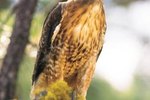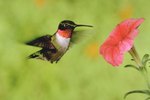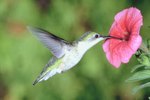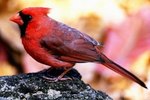
Hummingbirds may be the smallest birds in the animal world, but their feathers make big impressions. From vibrant colors to mating calls, the feathers that adorn these minute winged creatures not only look beautiful to admiring human observers, they also serve important purposes in these delicate birds' daily lives.
Attractive Colors
Hummingbird feathers come in a wide variety of colors, from dull brown to vibrant green to crimson red, and appear to have multiple tones and an iridescent glow. The ruby-throated hummingbird is one of the most popular members of the family, with bright red feathers on its throat and green feathers covering the rest of its body. The feathers of these brightly colored birds appear to have an iridescent sheen that appears in sunlight. Though less colorfully adorned species like the rufous hummingbird have duller feathers, all hummingbird feathers have pigmentation in the structure that creates the appearance of different colors depending on the position of the bird and the reflection of the sun. Because these small birds have dense feathers, the effect of the multi-tonal coloration is intensified.
Small Birds, Lots of Feathers
The hummingbirds' tiny bodies have lots of feathers for their petite size. A typical hummingbird has more than 900 feathers on its body, which translates into a ratio of more feathers per body size than that of any other bird species.
Wing Feather Sounds
Did you know that feathers on hummingbirds' wing feathers actually chirp? If you've ever witnessed a hummingbird in your flower garden or hovering over a feeder, you may have heard a distinct buzzing sound that is similar to that of a bee. This is the result of the rapid movement of hummingbirds' wings and the wind rustling through their wing feathers. The combination gives off the sound of this distinctive buzz that helps hummingbirds communicate with each other. The bee hummingbird actually gets its name not only from its tiny size, but the buzzing its wing feathers make in flight.
Using Tail Feathers for Mating
Hummingbird feathers also come in handy when males are searching for mates. Shrill squeaks that were once thought to come from these tiny birds' throats actually emit from their tail feathers while in flight. When male hummingbirds swoop and dive during mating, the rush of air and flickering of their tails make a high octave sound that attracts females. These tail feather sounds differentiate between species and sex, which helps hummingbirds attract perfect mates.
References
Photo Credits
-
NA/Photos.com/Getty Images
Writer Bio
Jennifer Lynn has been writing as a correspondent and reporter since 1991. She has written for numerous newspapers and currently writes as a correspondent for Gannett. Lynn has a Bachelor of Arts with a focus on English from Ohio University, where she also studied journalism at the E.W. Scripps School of Journalism.




